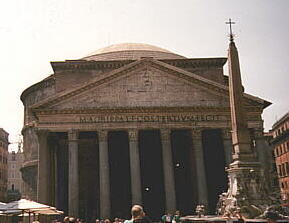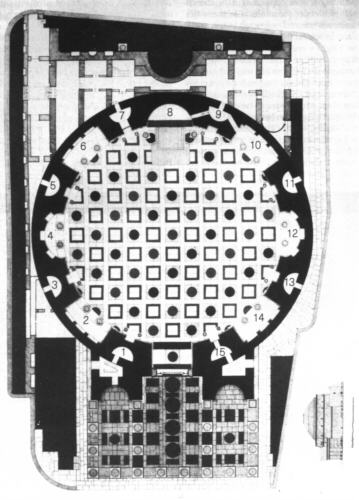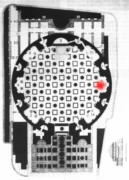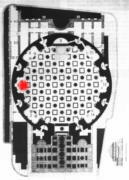Roma - Pantheon
Santa Maria ad Martyres - Pantheon
Roman temple consecrated as a church, dedicated to Our Lady and all martyrs.

History
The Pantheon was built by Marcus Vipsanius Agrippa in 27 BC; this is recorded in the inscription on the architrave. It was restored by Emperor Hadrian c. AD 120. He moved the entrance from the original position on the opposite side. The inscirption naming Agrippa as the builder was kept. It was built in honour of Augustus, and dedicated to the dynastic gods of the Julio-Claudian family: Mars, Venus and Julius Caesar. The meaning of the dedication to all the gods, Pantheon, is somewhat uncertain - it may have actually been a dedication to a single deity, Nature, which in a sense includes and surrounds all the other deities.
It was restored by Emperor Septimius Severus and his son and co-emperor Caracalla in AD 202. They placed a second inscription below the original one. This is now lost, but it was recorded as saying: IMP CAES L SEPTIMIUS SEVERUS ... ET IMP M AURELIUS ANTONINUS... PANTHEUM VETUSTATE CORRUPTUM CUM OMNI CULTU RESTITUERUNT, meaning "Emperor L. Septimius Severus... and Emperor M. Aurelius Antoninus... carefully restored the Pantheon, ruined by the passage of the years".
The temple was closed in the 5th century, and in 608/9 Emperor Phocas gave it to Pope Boniface IV so that it could be turned into a church. It was consecrated and dedicated to Our Lady and all the martyrs. In 609, Boniface IV confirmed All Saints Day as a feast.
In 663, Emperor Constans II visited Rome, and stripped the city of much of its bronze and precious metals, including much of the bronze from the roof. Pope Gregory III had it reclad with lead in 735. At some point, a belfry was added to the portico.
In the period when the papacy was based in Avignon (1309-1377), the church fell into disuse and was used at one time as a fortress, and later as a poultry market. With the return of the Pope from Avignon to Rome, it was restored.
Pope Urban VIII (1623-1644) replaced one of the granite columns (the first on the left) and had the belfry demolished. He then had two bell-towers built on top of the second, internal pediment; they were designed by Bernini. Two other columns on the left side were replaced by Pope Alexander VII (1657-1667). He used columns in red granite found in the Alexandrine baths near San Luigi dei Francesi. Pope Innocent XI (1676-1689) had the roof repaired.
The last restorations performed by the popes where those of Pius VII (1800-1823) around 1820 and Pius IX in 1857. After that, the Italian government took over the responsibility, and the building is now placed in the care of the Soprintendenze, the archaeological authorities. They have recently carried out a major restoriation and cleaning programme.
It was a parish church from the 10th century until 1824. Since 1929, it has been the seat of the Military Ordinary of Italy. The church is served by ecclesistical Canons.
Exterior
The building consists of a circular hall with a colonnaded sqaure and an entrance portico.
The entrance portico has 16 monolithical granite columns. The costmust have been enourmous - in ancient times, transport was quite expensive, and the columns were brought all the way from Egypt. Originally, eight were of gray-green and eight of pink granite. The side door in the portico is the entrance to the rooms of the Confraternity of the Virtuosi.
The circular hall was built with ingenious use of relieving arches. The cupola needs a lot of support, and this could be solved by building massive walls. But the area was marshy, and there is a danger that the building would have started sinking. By using arches, the walls became much lighter.
The inscription on the architrave reads: M AGRIPPA L F COS TERTIUM FECIT, meaning "Marcus Agrippa son of Lucius built this while consul for the third time".
The roof was originally covered with gilded bronze. Some of it was taken by the Byzantine Emperor Constans II in 663, and some was taken in 1632 to be used by Bernini for the columns of the canopy above the high altar of St Peter's. The surplus after Bernini had finished was used for a cannon at Castel Sant' Angelo. The bronze doors are among the few Roman bronze doors that have survived; they are however heavily restored.

Interior
Santa Maria ad Martyres - Plan
- Assumption, oil on canvas by Camassei
- Chapel of St Joseph of the Holy Land (Chapel of the Virtuosi)
- St Agnes, statue by Felici
- Tomb of Umberto I and Margaret of Sacoy
- Raphael's tomb
- Chapel of the Crucifixion
- St Athanasius, statue by Moderati
- Sanctuary and high altar
- St Rasio, statue by Cametti
- Chapel of the Madonna of Mercy
- St Anne and the Blessed Virgin, statue by Il Lorenzone
- Tomb of Victor Emmanuel II
- Incoronation of the Virgin, fresco of the Tuscan school
- Chapel of the Annunciation
- Madonna of the Girdle and St Nicholas of Bari, oil on canvas.
The Pantheon never fails to have an impact on visitors. The magnificent dome, a monument to the Roman invention of concrete and Roman architectual skill, creates a unique sense of space in the building, and the simple marble decorations emphasize the architectural perfection.
The coffered dome has a diameter of 43.30 metres, which means that it's the largest masonry dome ever built; wider than the dome at St Peter's, but not as big in volume. No matter its size relative to other cupolas, the fact that it covers the entire hall gives it more impact than domes that cover only part of a larger building - it encloses the viewer in a special way. The height from the floor to the middle of the dome (actually, where the middle of the dome would have been had it not been open) is also 43.30 metres. The cassettes were originally painted blue in the middle, and each had a bronze star.
The interior wall has niches, framed by polychrome marble columns. Decorations are mainly marble in opus sectile (abstract patterns of coloured marble tiles). The small niches held memorial portrait busts, mainly of the members of the Virtuosi. This tradition started in 1766, but was brought to an end by Pope Pius VII (1800-1823) who moved the busts to the Protomoteca Capitolina, which he had founded in 1820.
Sanctuary
The high altar and the apse were rebuilt by Pope Clement XI (1700-1721). The altar was designed by Alessandro Specchi. In the apse, a copy of an icon of the Madonna in the Byzantine style is enshrined. The original, now in the Chapel of the Canons, has been dated to the 13th century, although tradition claims that it is much older. The apse painting, Glory of all the Saints, was painted in 1544 by Giovanni Guerra. The choir was added in 1840, and was designed by Luigi Poletti.
Right side of the hall
The first niche holds the canvas The Madonna of the Girdle and St Nicholas of Bari, painted in 1686 by an unknown artist.
On the right side, the first chapel, the Chapel of the Annunciation, has a fresco of the Annunication attributed to Melozzo da Forli. When this was a parish church, from the 10th century until 1824, the baptismal font was placed here. On the left side is a canvas by Clement Maioli, St Lawrence and St Agnes, painted 1645-1650. On the right side is the canvas from 1633, The Incredulity of St Thomas, by Pietro Paolo Bonzi.
The second niche has a 15th century fresco of the Tuscan school, The Incoronation of the Virgin.

In the second chapel is the tomb of King Victor Emmanuel II (died 1878). It was originally dedicated to the Holy Spirit. A competition was held to decide which architect should be given the honour of designing it. Giuseppe Sacconi participated, but lost - he would later design the tomb of Umberto I in the opposite chapel. Manfredio Manfredi won the competition, and started work in 1885. The tomb consists of a large bronze plaque sumounted by a Roman eagle and the arms of the house of Savoy. The golden lamp above the tomb burns in honour of Victor Emmanuel III, who died in exile in Alexandria, Egypt in 1947.
The third niche has a sculpture by Il Lorenzone of St Anne and the Blessed Virgin.
In the third chapel is a 15th century painting of the Umbrian school, The Madonna of Mercy between St Francis and St John the Baptist. It is also known as the Madonna of the Railing, because it originally hung in the niche on the left-hand side of the portico, where it was protected by a railing. It was moved to the Chapel of the Annunciation, and then to its present position some time after 1837. The bronze epigram commemorated Pope Clement XI's restoration of the sanctuary. On the right wall is the canvas Emperor Focas presenting the Pantheon to Pope Boniface IV, painted in 1750 by an unknown artist. Three memorial plaques are placed in the floor, the one commemorating a Gismonda written in the vernacular.
The final niche on the right side has a statue of St Rasio by Bernardino Cametti, made in 1725.
Left side of the hall
On the left side, the first niche has a canvas by Andrea Camassei, the Assumption from 1638.
The first chapel it the Chapel of St Joseph in the Holy Land, and is the chapel of the Confraternity of the Virtuosi at the Pantheon. This refers to the confraternity of artists and musicians that was formed here by a 16th century Canon of the church, Desiderio da Segni, to ensure that worship was maintained in the chapel. The first members were, among others, Antonio da Sangallo the younger, Jacopo Meneghino, Giovanni Mangone, Taddeo Zuccari, Domenico Beccafumi and Flaminio Vacca. The confraternity continued to draw members from the elite of Rome's artists and architects, and among later members we find Gian Lorenze Bernini, Pietro da Cortona, Allessandro Algardi and many others. The institution still exists, and is now called the Academia Ponteficia di Belle Arti (The Pontifical Academy of Fine Arts), based in the palace of the Cancelleria. The altar in the chapel is covered with false marble. On the altar is a statue of St Joseph and the Holy Child, by Vincenzo de Rossi. To the sides are paintings by Francesco Cozza, one of the Virtuosi: the Adoration of the Shepherds on the left side and The Adoration of the Magi on the right. Both were painted in 1661. The stucco relief on the left side, the Dream of St Joseph is by Paolo Benaglia, and the one on the right side, Rest During the Flight from Egypt is by Carlo Monaldi. On the vault are several 17th century canvases, from left to right: The Cuman Sibyl by Ludovico Gemignani; Moses by Francesco Rosa; The Eternal Father by Giovanni Peruzzini; David by Luigi Garzi and finally The Eritrean Sibyl by Giovanni Andrea Carlone.
The second niche has a statue of St Agnes, by Vincenco Felici. The bust on the left is a portrait of Baldassare Peruzzi, derived from a plaster portrait by Giovanni Duprи.

The tomb of King Umberto I and his wife Margherita di Savoia is in the next chapel. The chapel was originally dedicated to St Michael the Archangel, and then to St Thomas the Apostle. The present design is by Giuseppe Sacconi, completed after his death by his pupil Guido Cirilli. The tomb consists of a slab of alabaster mounted in gilded bronze. The frieze has allegorical representations of Generosity, by Eugenio Maccgnani, and Munificence, by Arnaldo Zocchi. The royal tombs are maintained by the National Institute of Honour Guards to the Royal Tombs, founded in 1878. They also organize picket guards at the tombs. The altar with the royal arms is by Cirilli.
The third niche holds the mortal remains - his Ossa et cineres, "Bones and ashes", as the inscription on the sarcophagus says - of the great artist Raphael. His fiancee, Maria Bibbiena is buried to the right of his sarcophagus; she died before they could marry. The sarcophagus was given by Pope Gregory XVI, and its insription reads ILLE HIC EST RAPHAEL TIMUIT QUO SOSPITE VINCI / RERUM MAGNA PARENS ET MORIENTE MORI, meaning "Here lies Raphael, by whom the mother of all things (Nature) feared to be overcome whilst he was living, and whilst he was dying, herself to die". The epigraph was written by Pietro Bembo. The present arrangement is from 1811, designed by Antonio Munoz. The bust of Raphael is by Giuseppe Fabris, made in 1833. The two plaques commemorate Maria Bibbiena and Annibala Caracci. Behind the tomb is the statue known as the Madonna del Sasso, Madonna of the Rock, named so because she rests one foot on a boulder. It was commissioned by Raphael and made by Lorenzetto in 1524.
In the Chapel of the Crucifixion, you can see the Roman brick wall with three niches. The wooden crucifix on the altar is from the 15th century. On the left wall is a canvas by Pietro Labruzi, Descent of the Holy Ghost, from 1790. On the right side is the low relief Cardinal Consalvi presents to Pope Pius VII the five provinces restored to the Holy See, made by the Danish sculptor Bertel Thorvaldsen in 1824. The bust is a portrait of Cardinal Agostino Rivarola.
The final niche on this side has a statue of St Athanasius, made in 1717 by Francesco Moderati.
Special notes
Although it is a church, this is hardly noticed by most visitors. Masses are held on special occasions, such as the Feasts of the Ascension and Assumption which were traditionally celebrated with great solemnty here, but most of the time it is like any other ancient monument. If you go here early in the morning, just after it has opened, you'll be able to enjoy it without the background noise of hundreds of tourists - this makes it easier to appreciate that it is in fact a church.